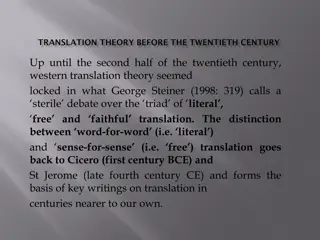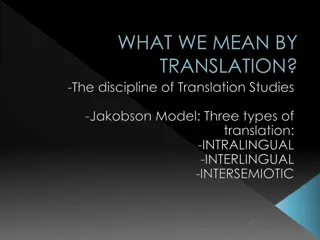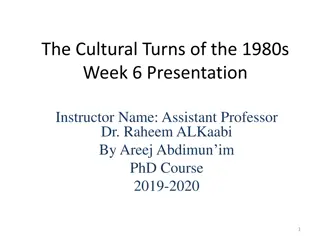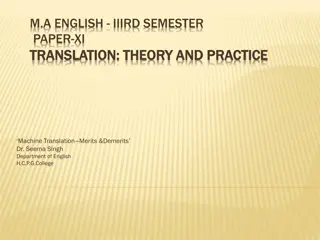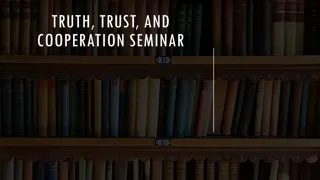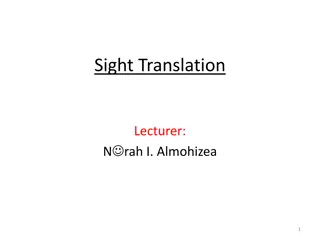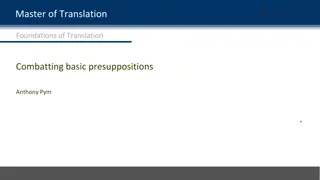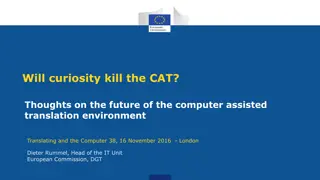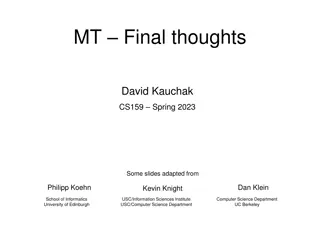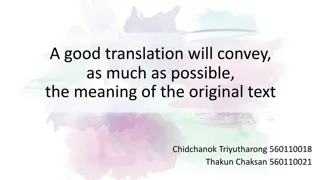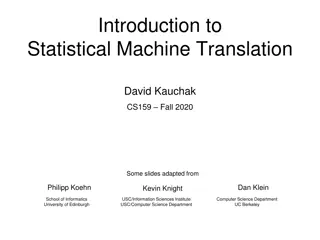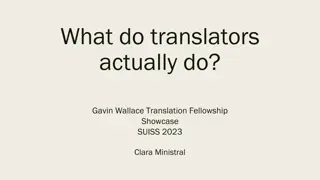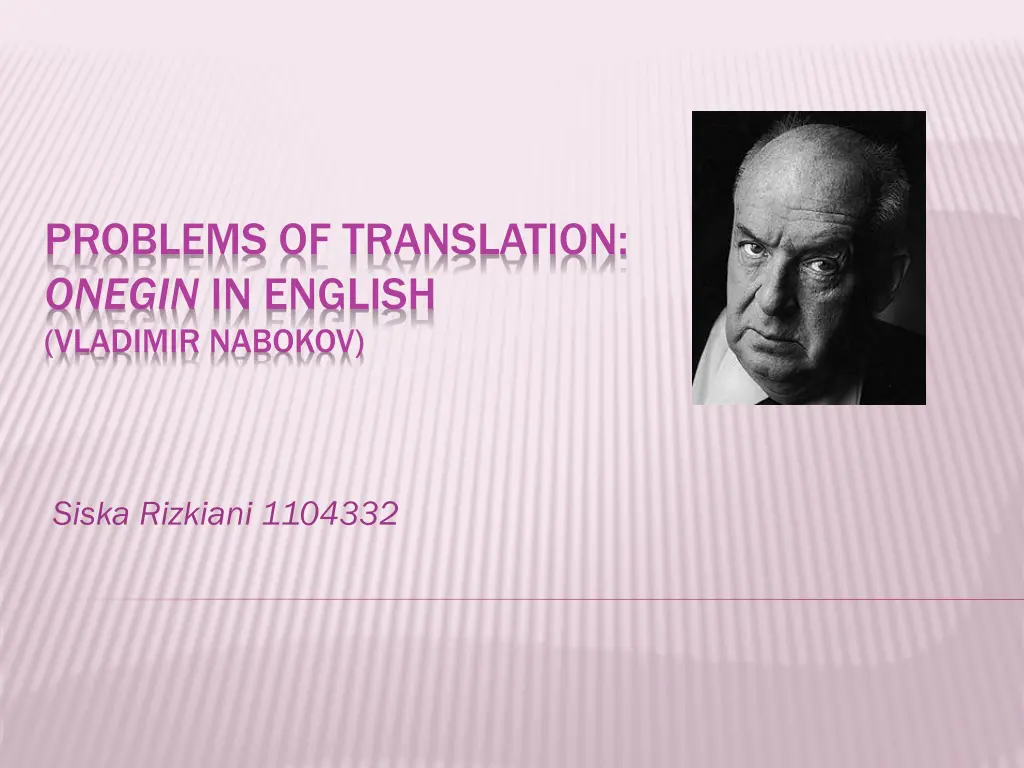
Translation Challenges in Nabokov's Onegin: Issues and Solutions
Exploring the complexities of translating Vladimir Nabokov's "Onegin" into English, including differences in language and prosody, the significance of Pushkin, the essence of Onegin, and the nuances of literal translation.
Uploaded on | 1 Views
Download Presentation

Please find below an Image/Link to download the presentation.
The content on the website is provided AS IS for your information and personal use only. It may not be sold, licensed, or shared on other websites without obtaining consent from the author. If you encounter any issues during the download, it is possible that the publisher has removed the file from their server.
You are allowed to download the files provided on this website for personal or commercial use, subject to the condition that they are used lawfully. All files are the property of their respective owners.
The content on the website is provided AS IS for your information and personal use only. It may not be sold, licensed, or shared on other websites without obtaining consent from the author.
E N D
Presentation Transcript
PROBLEMS OF TRANSLATION: ONEGIN IN ENGLISH (VLADIMIR NABOKOV) Siska Rizkiani 1104332
PARTS OF CHAPTER II. What are the differences? III. Who is Pushkin? I. What is Onegin? IV. What is literal translation? V. What are the facts found? VI. What are the results? VII. What are the conclusions?
I. WHAT IS ONEGIN? concerned with the afflictions, affections, and fortunes of 3 young men (Onegin, Lenski, and Pushkin), and 3 young ladies (Tatiana, Olga, and Pushkin s Muse). contained 8 chapters and 5,551 lines is a Russian novel in verse 1stcomplete edition published in Spring of 1833 in St. Petersburg taken place between the end of 1819 and the spring of 1825 written from May 1823 to October 1831 at midway between Opochka and Moscow.
II. WHAT ARE THE DIFFERENCES? -BETWEEN RUSSIAN, FRENCH, AND ENGLISH - IN TERMS OF LANGUAGE AND PROSODY The number of rhymes, both masculine and feminine is comparably greater that in English and leads to the cult of the rare and the rich. No matter the length of a word in Russian there is never a secondary accent or two accents as occurs in English. Polysyllabic words are considerably more frequent than in English In Russian, all syllables are fully pronounced.; there are no elisions and slurs as there are in English verse Inversion so commonly met with in English iambics. In Russian is rare. Russian poems composed in iambics tetrameter contain a larger number of modulated lines than of regular ones, while the reserve is true in regard to English poems.
III. WHO IS PUSHKIN? Alexandr Sergeyev Pushkin (1799-1837) A national poet of Russia Produced a product of French literature as much as of Russian culture Zhukovski and Batyushkov were the predecessors of Pushkin; harmony and precision He was acquainted with English poets only through the French models or French versions
IV. WHAT IS LITERAL TRANSLATION One who desires to turn a literary masterpiece into another language has only one duty to perform To reproduce with absolute exactitude the whole text, and nothing but the text Literal translation is tautological (repeat what has already said) since anything but that is not truly a translation but an imitation, an adaptation or a parody. Literal translation or directed translation, is rendering of text from one language to another word-by-word, rather than conveying the sense of the original The problem is a choice between rhyme and reason; can a translation keep the form of the original, its rhythm and its rhyme?
EXAMPLE It s raining cats and dogs It s raining cats and dogs hujan hujan kucing kucing dan The sooner or the later the weather will change The sooner or the later the weather will change lebih lebih cepat cepat atau atau lebih lebih lambat (tak bermakna dan tak lazim). dan anjing anjing akan berubah berubah. lambat cuaca cuaca akan This approach should be the beginning process of translation (Machali, 2009)
V. WHAT ARE THE FACTS FOUND? (FROM THE FRENCH, ENGLISH & GERMAN VERSION OF ONEGIN) germanLippert (1840) frenchTurgenev & Viardot Dupont (1847) More idiomatic englishLieut,-Col.Spalding 1937, 1938) Dorothea Prall Radin & George Z.Patrick (1937) All contains ingenuity, dreadful verse, mistranslations. (1863) A really good translation (1881) Babette Deutsch (1936) Oliver Elton (1936, Seubert (1873) Bodenstedt (1854) are the worst of the a lot
VI. WHAT ARE THE RESULTS? Pushkin s line is an excellent illustration of what Nobokov means by literalism, literality, literal interpretation . He takes literalism as absolute accuracy The translator should constantly bear in mind not only the essential pattern of the text but also the borrowings with which that pattern is interwoven. Nor can anything can be added for the sake of rhyme or meter.
VII. WHAT ARE THE CONCLUSIONS? 1. It is impossible to translate Onegin in rhyme. 2. It is possible to describe in a series of footnotes the modulations and rhymes of the text as well as all its associations and other special features. 3. It is possible to translate Onegin with reasonably accuracy by substituting for 14 rhymed tetrameter lines of each stanza 14 unrhymed lines of varying length, from iambic dimeter to iambic pentameter.
The clumsiest literal translation is a thousand times more useful than the prettiest paraphrase (Vladimir Nobokov) THANK YOU




